Respiration A-Level Biology.
1/62
There's no tags or description
Looks like no tags are added yet.
Name | Mastery | Learn | Test | Matching | Spaced |
|---|
No study sessions yet.
63 Terms
What are the stages of respiration?
1. Glycolysis
2. Link reaction
3. Krebs cycle
4. Oxidative phosphorylation - electron transport chain.
Where does glycolysis occur?
Is it aerobic or anaerobic?
In the cytoplasm.
It is an anaerobic process - does not require oxygen.
Give the main steps of glycolysis. (Just name them).
Phosphorylation.
Lysis.
Phosphorylation.
Dehydrogenation and formation of ATP.
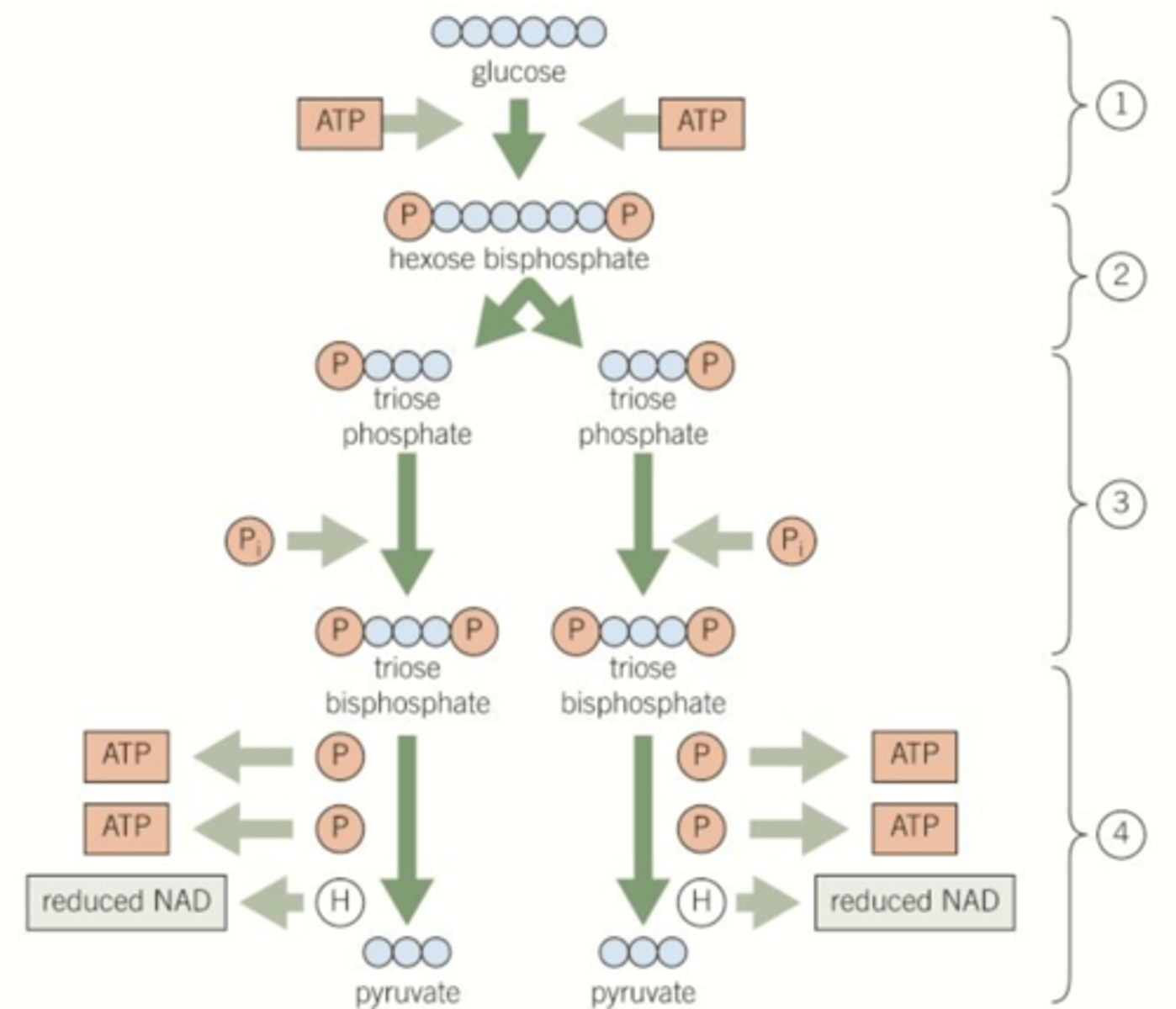
What happens in the first step of glycolysis - phosphorylation?
Two phosphates are release from two ATP molecules, and are attached to a glucose molecule forming hexose bisphosphate.
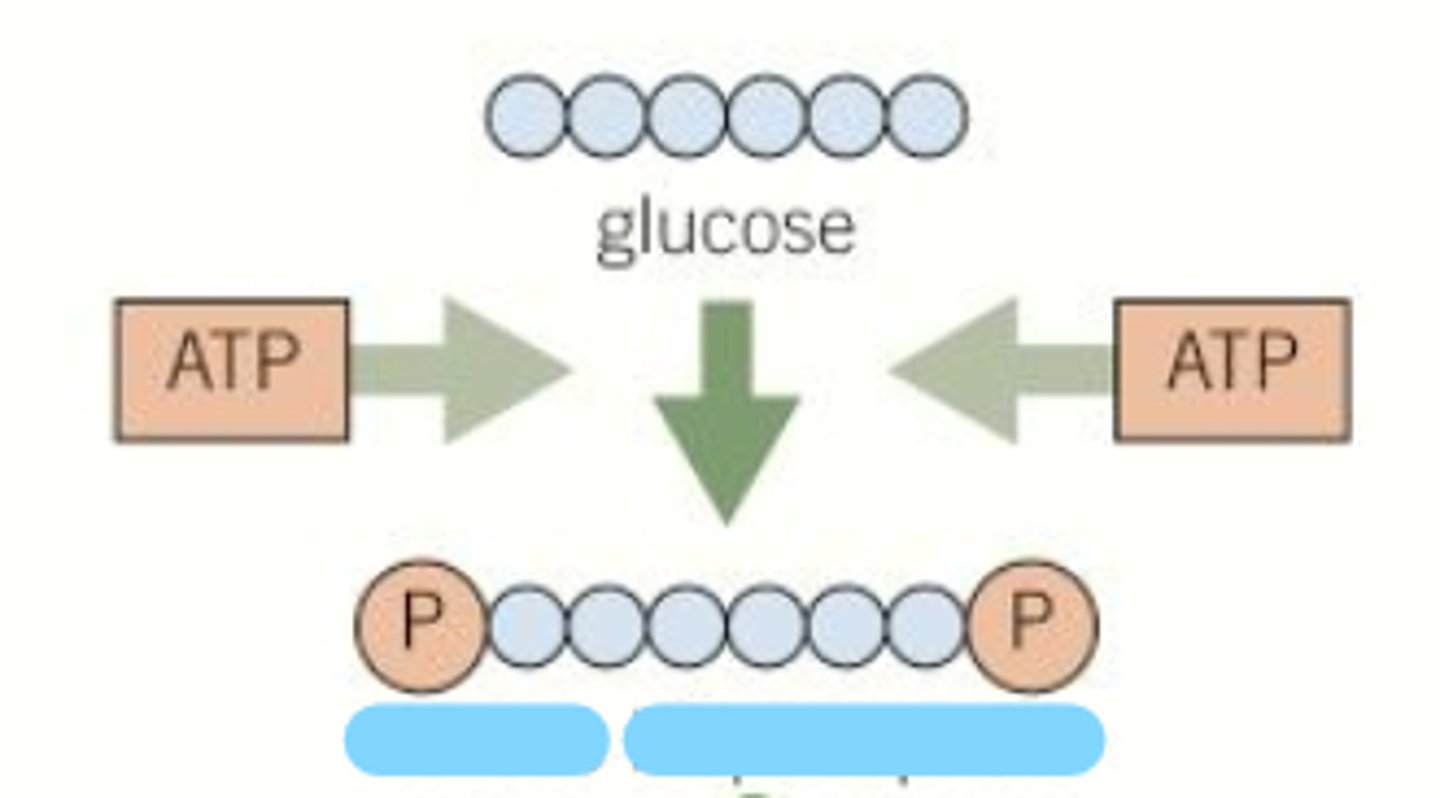
What happens in the second step of glycolysis - lysis?
This destabilises the molecule causing it to split into two triose phosphate molecules.
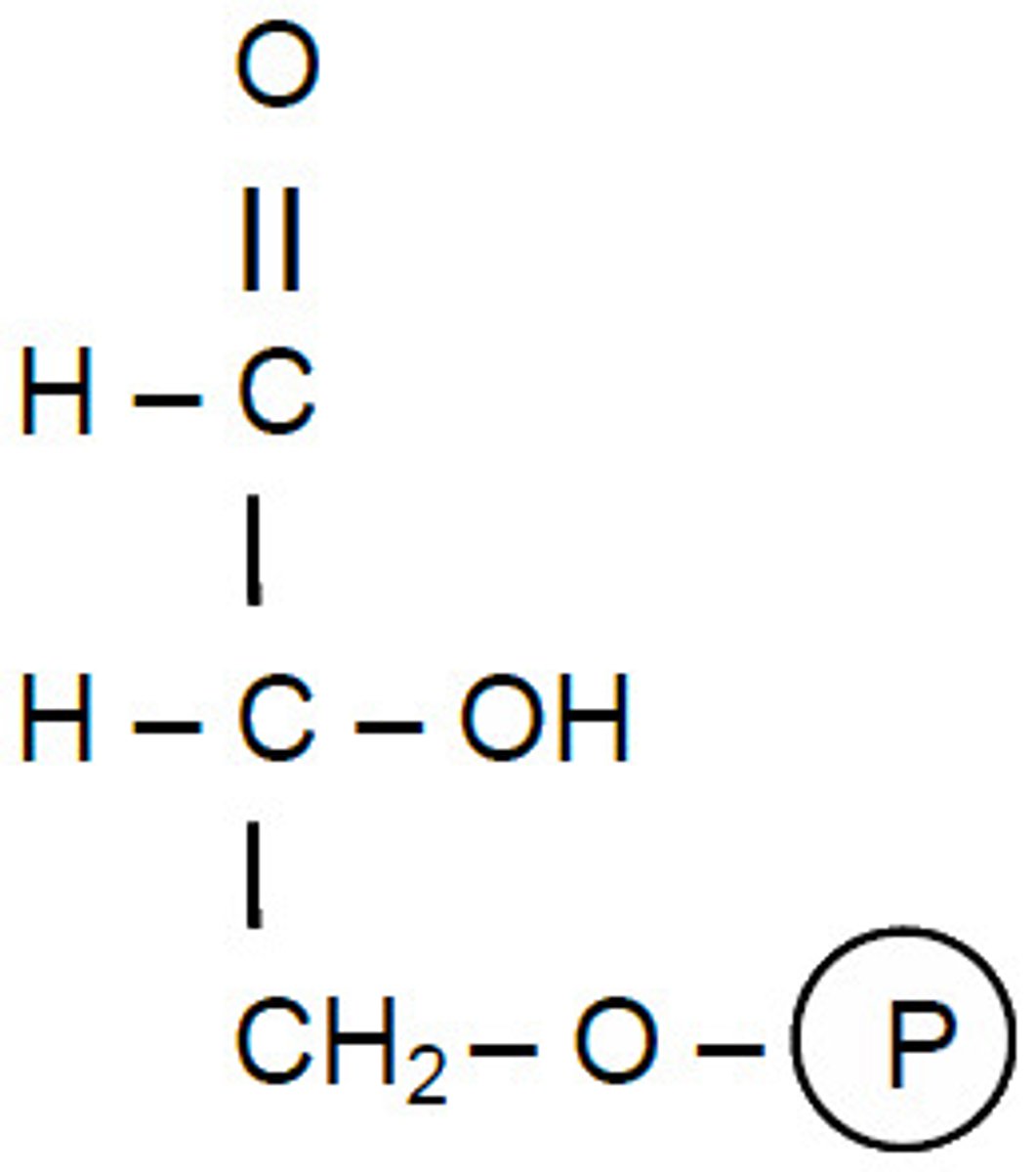
What happens in the third step of glycolysis - phosphorylation?
Another phosphate group is added to each triose phosphate forming two triose bisphosphate molecules.
These phosphate groups come from free inorganic phosphate (Pi) ions present in the cytoplasm.

What happens in the fourth step of glycolysis - dehydrogenation and formation?
The two triose bisphosphate molecules are then oxidised by the removal of hydrogen atoms (dehydrogenation) to form two pyruvate molecules.
NAD coenzymes accept the removed hydrogens - they are reduced, forming two reduced NAD molecules.
(look at bottom section of the diagram).

What happens at the same time of the 4th step of glycolysis, and what is this an example of?
Four ATP molecules are produced using phosphates from the triose bisphosphate molecules.
This is an example of substrate level phosphorylation.
What is substrate level phosphorylation?
The formation of ATP without the involvement of an electron transport chain.
ATP is formed by the transfer of a phosphate group from triose bisphosphate to ADP.
What is the net ATP yield of glycolysis?
2 ATP.
Now all together, describe the full process of glycolysis.
Two phosphates are release from two ATP molecules, and are attached to a glucose molecule forming hexose bisphosphate.
This destabilises the molecule causing it to split into two triose phosphate molecules.
Another phosphate group is added to each triose phosphate forming two triose bisphosphate molecules. These phosphate groups come from free inorganic phosphate (Pi) ions present in the cytoplasm.
The two triose bisphosphate molecules are then oxidised by the removal of hydrogen atoms (dehydrogenation) to form two pyruvate molecules.
NAD coenzymes accept the removed hydrogens - they are reduced, forming two reduced NAD molecules.
Four ATP molecules are produced using phosphates from the triose bisphosphate molecules.
The reduced NAD is used in a later stage to synthesise more ATP.
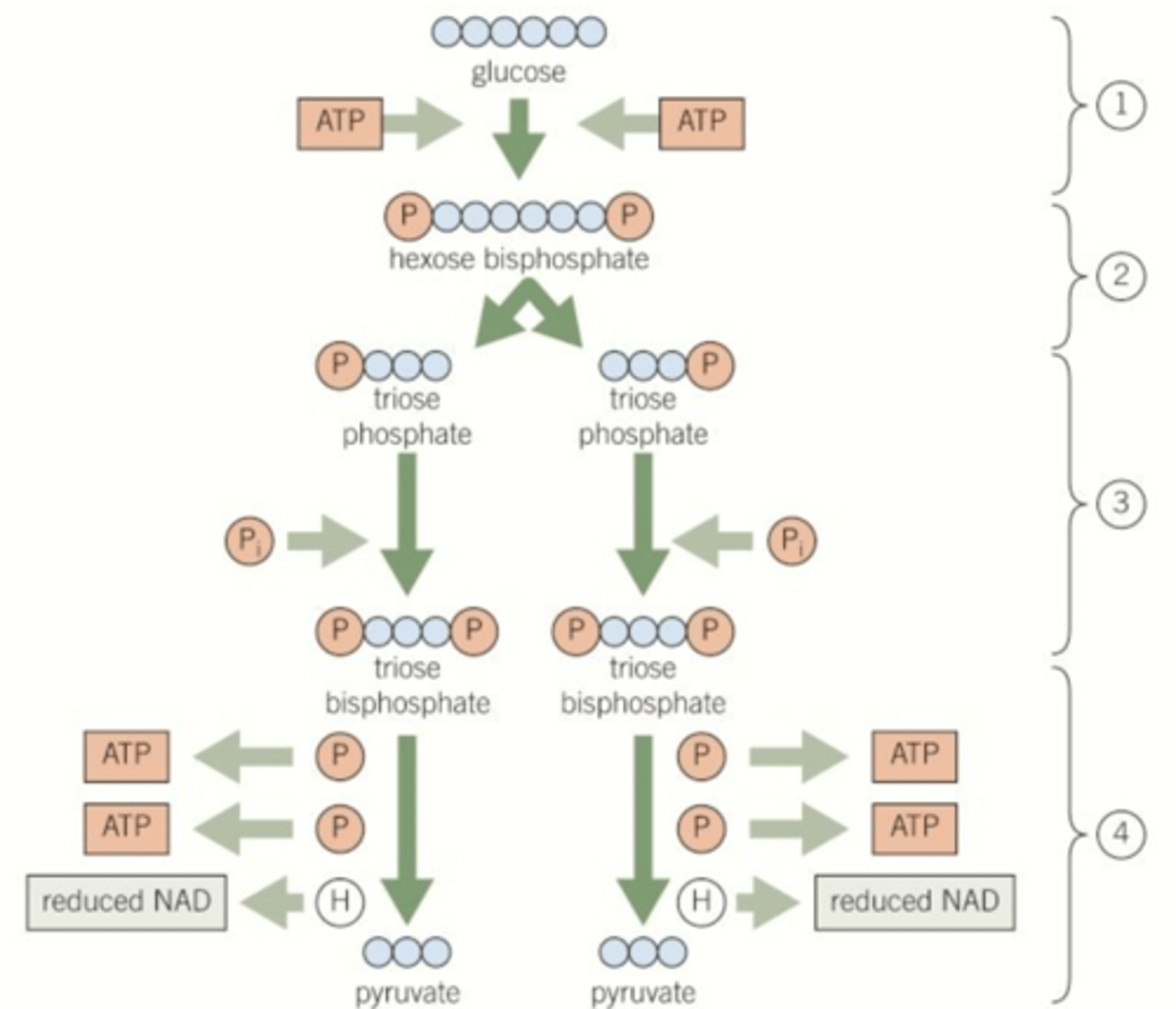
What are the products of glycolysis?
2 ATP, 2 NADH and 2 pyruvate.
Where do the rest of the aerobic reactions of cellular respiration take place?
In the mitochondria.
What is the space between the double membrane of the mitochondria called?
The intermembrane space.
Protons are pumped into this space by an electron transport chain.
The space is small so the concentration builds up quickly.
What is the mitochondrial matrix?
The space inside the inner membrane of the mitochondria.
Contains enzymes for the Krebs cycle and the link reaction, and contains mitochondrial DNA.
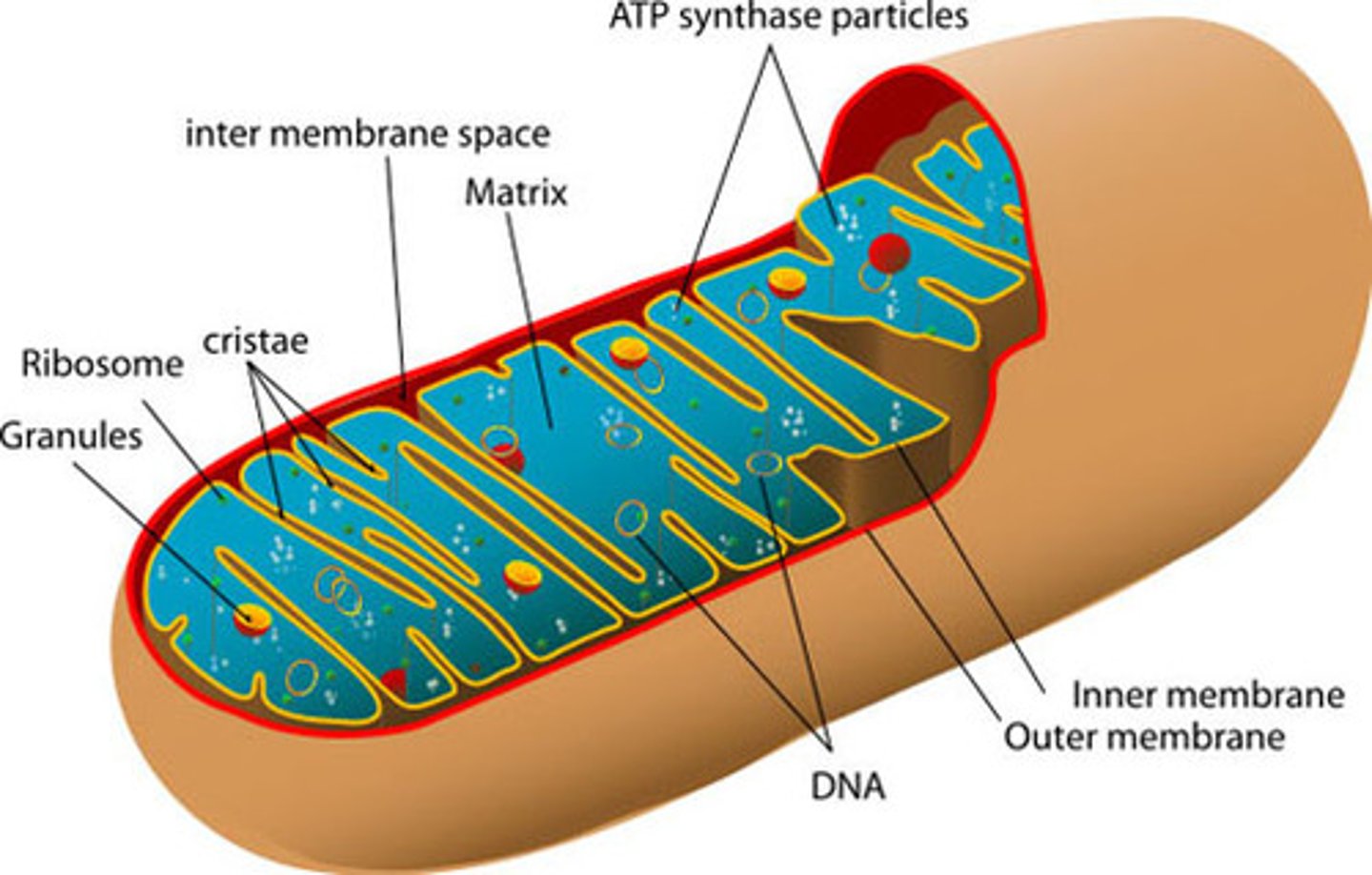
What is the role of the outer mitochondrial membrane?
Separates the contents of the mitochondrion from the rest of the cell, creating a cellular compartment with ideal conditions for aerobic respiration.
What is the role of the inner mitochondrial membrane?
Contains electron transport chains and ATP synthase.
What are cristae?
Projections of the inner membrane which increase the surface area available for oxidative phosphorylation.
What is the purpose of the link reaction?
(Oxidative decarboxylation)
Links anaerobic glycolysis to the aerobic steps of respiration, occurring in the mitochondria.
What are the stages of the link reaction.
Pyruvate enters the mitochondrial matrix by active transport.
Pyruvate then undergoes oxidative decarboxylation - CO2 is removed (decarboxylation) along with hydrogen (oxidation).
Hydrogen atoms are accepted by NAD, which is reduced to form NADH.
The resulting two-carbon acetyl group is bound to coenzyme A forming acetylcoenzyme A (acetyl CoA).
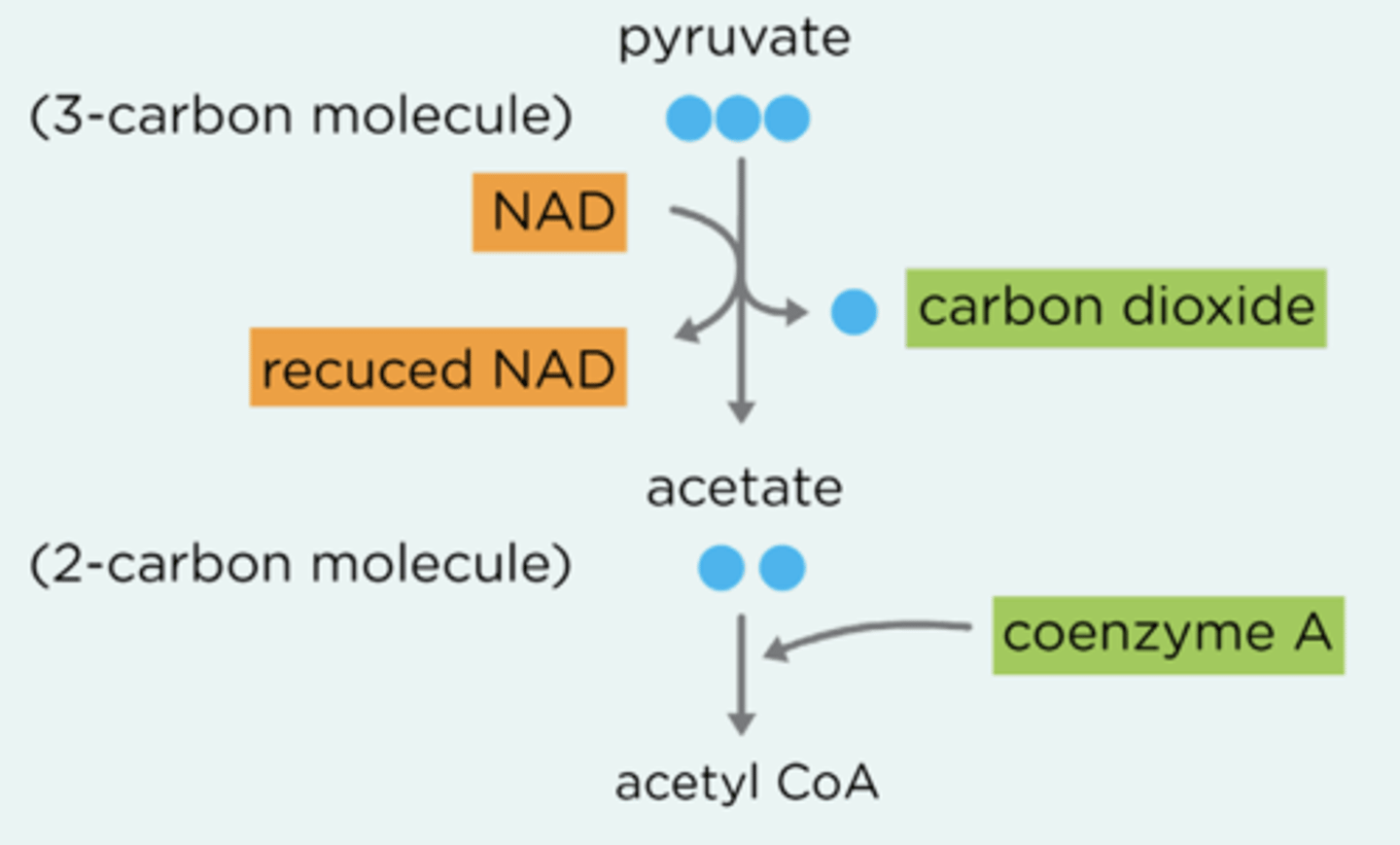
What is oxidation?
Removal of hydrogen.
(gain of oxygen, the loss of hydrogen or the loss of electrons).
What is decarboxylation?
The removal of carbon dioxide from a molecule.
What is the purpose of acetyl CoA?
And the NADH that is produced.
(NADH = reduced NAD)
Acetyl CoA delivers the acetyl group to the next stage of aerobic respiration, the Krebs cycle.
The reduced NAD is used in oxidative phosphorylation to synthesise ATP.
What happens to the CO2 from the link reaction?
Will either diffuse away and be removed as metabolic waste or, in autotrophic organisms, may be used as a raw material in photosynthesis.
How many times does the link reaction happen, for each molecule of glucose?
Twice, as two pyruvate molecules are produced in glycolysis.
Where does the Krebs cycle take place in?
The mitochondrial matrix.
What does the Krebs cycle result in?
Results in the breakdown of an acetyl group.
Acetyl groups are all that remain of the glucose that entered glycolysis.
What are three key processes that occur in the Krebs cycle?
Decarboxylation.
Dehydrogenation.
Substrate level phosphorylation.
What coenzymes pick up the hydrogen atoms released in the Krebs cycle?
What are the other products of the cycle?
NAD and FAD.
Carbon dioxide is a by-product of these reactions.
The ATP produced is available for use by energy-requiring processes within the cell.
What is the role of the reduced NAD and reduced FAD produced in the Krebs cycle?
They are used in the final step of aerobic respiration, to produce large quantities of ATP by chemiosmosis.
What does the acetyl group bind to in the first stage of the Krebs cycle?
What does it form?
The four-carbon oxaloacetate.
This forms the six-carbon citrate.
Describe the stages of the Krebs cycle.
Acetyl CoA delivers an acetyl group to the Krebs cycle. The two-carbon acetyl group combines with the four-carbon oxaloacetate to form six-carbon citrate.
The citrate molecule undergoes decarboxylation and dehydrogenation producing one NADH and CO2. A five carbon compound is formed.
The five-carbon compound undergoes further decarboxylation and dehydrogenation reactions, eventually regenerating oxaloacetate, so the cycle continues.
What are the products of the Krebs cycle?
More CO2 is produced.
Two more reduced NADs.
One reduced FAD.
ATP is also produced by substrate-level phosphorylation.
What are the two main coenzymes in respiration?
NAD and FAD both accept protons and electrons released during the breakdown of glucose in respiration.
What are the differences between NAD and FAD?
NAD takes part in all stages of respiration, FAD only accepts hydrogens in the Krebs cycle.
NAD accepts one hydrogen and FAD accepts two hydrogens.
Reduced NAD is oxidised at the start of the electron transport chain, releasing protons and electrons while FAD is oxidised further along the chain.
Reduced NAD results in the synthesis of three ATP molecules, reduced FAD results in the synthesis of two ATP.
What happens after the Krebs cycle?
Oxidative phosphorylation - electron transport chain.
Hydrogen atoms that have been collected by NAD and FAD are delivered to the electron transport chain, present in the membranes of the cristae of the mitochondria.
Explain how ATP is synthesised from an electron transport chain.
Hydrogen atoms dissociate into hydrogen ions and electrons.
High energy electrons are used to synthesise ATP by chemiosmosis:
Energy is released during the redox reactions as electrons reduce and oxidise electron carriers, creating a proton gradient leading to the diffusion of protons through ATP synthase resulting in the synthesis of ATP.
What happens at the end of the electron transport chain?
What is the final electron acceptor?
The electrons combine with hydrogen ions and oxygen to form water.
Oxygen is the final electron acceptor and the electron chain cannot operate unless oxygen is present. (Oxidative phosphorylation).
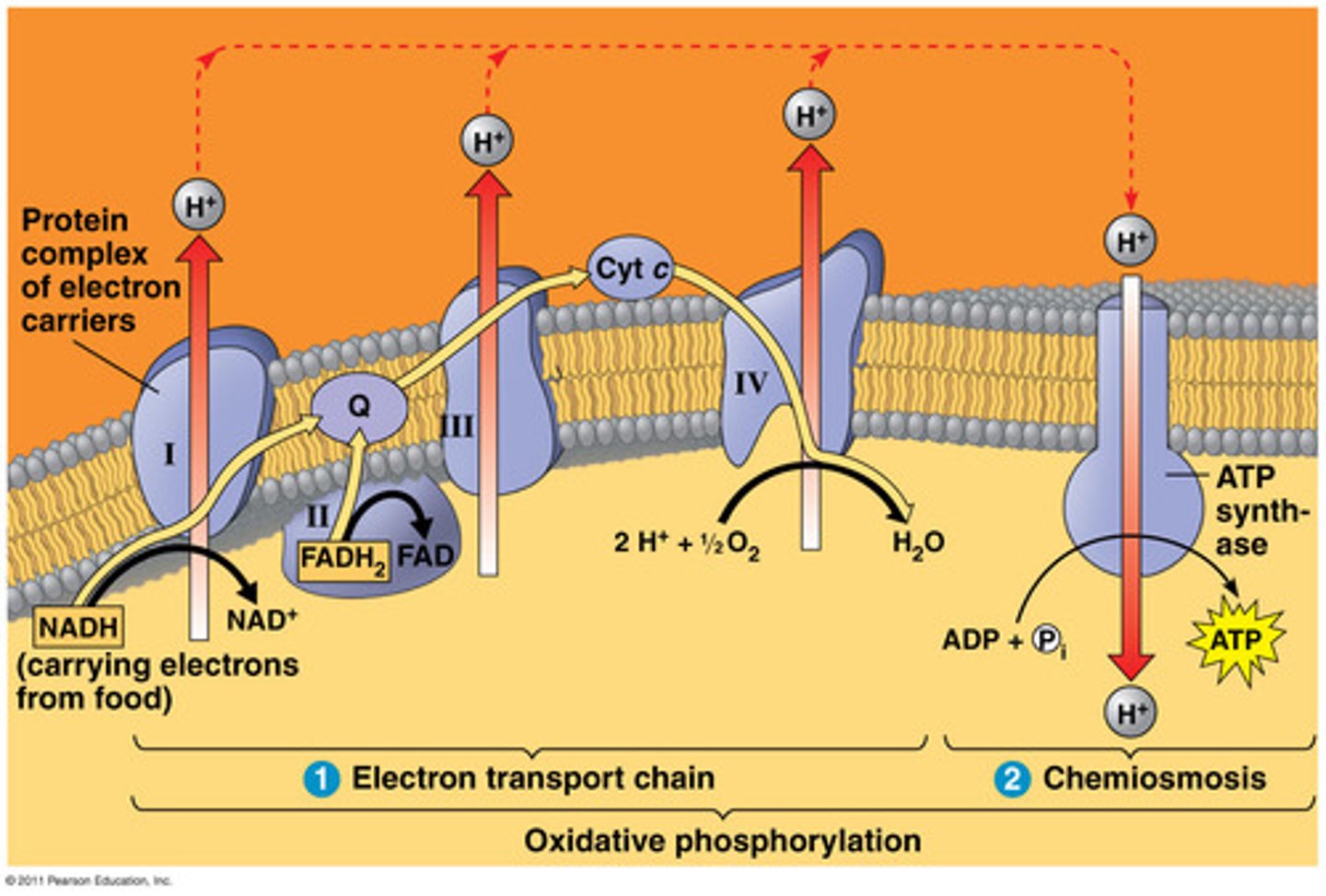
Give another example of substrate level phosphorylation.
Production of ATP from the transfer of a phosphate group from creatine phosphate.
How many net molecules of ATP does fermentation produce?
Fermentation (a form of anaerobic respiration) only produces two molecules of ATP. (net).
When is anaerobic respiration used in eukaryotic organisms?
Occurs in the absence of oxygen and is used when oxygen cannot be supplied fast enough to respiring cells.
What are the three categories of organisms that are determined by their dependence on oxygen or not?
Obligate anaerobes.
Facultative anaerobes.
Obligate aerobes.
What are obligate anaerobes?
Organisms that cannot survive in the presence of oxygen.
Almost all are prokaryotes, however there are some fungi as well.
What are facultative anaerobes?
Give an example.
Synthesise ATP by aerobic respiration if oxygen is present, but can switch to anaerobic respiration in the absence of oxygen.
An example is yeast.
What are obligate aerobes?
Can only synthesise ATP in the presence of oxygen (mammals).
Individual cells of some organisms can be described as facultative anaerobes as they can carry out anaerobic respiration when oxygen concentration is low, but this is only for short periods of time.
Anaerobic respiration produces compounds that have to be broken down when oxygen becomes available again, so the organism as a whole is an obligate aerobe.
What is fermentation?
The process by which complex organic compounds are broken down into simpler inorganic compounds without the use of oxygen or the involvement of an electron transport chain.
The small quantity of ATP produced is synthesised by substrate level phosphorylation.
What are the two types of fermentation?
Alcoholic fermentation and lactate fermentation.
What organisms carry out alcoholic fermentation?
What is produced in this reaction?
Yeast and some plant root cells.
Ethanol and carbon dioxide are produced.
What organisms carry out lactate fermentation?
Carried out in animal cells.
Lactate is produced.
What happens to the aerobic pathway in the absence of oxygen, and what occurs as a result?
(Talk about the key stages).
Oxygen can't act as the final electron acceptor, so the flow of electrons stop, ATP by chemiosmosis stops.
NADH and FADH can no longer be oxidised as there is nowhere for the electrons to go. This means NAD and FAD cannot be regenerated so the decarboxylation and oxidation of pyruvate and the Krebs cycle stops as there are no coenzymes to accept hydrogens being removed.
Glycolysis would come to a halt due to the lack of NAD if it were not for fermentation.
Explain lactate fermentation in mammals.
Give the name of the enzyme that catalyses this reaction.
Pyruvate can act as a hydrogen acceptor taking hydrogen from NADH, catalysed by the enzyme lactate dehydrogenase.
Pyruvate is converted to lactate and NAD is regenerated.
This keeps glycolysis going so a small quantity of ATP is still synthesised.
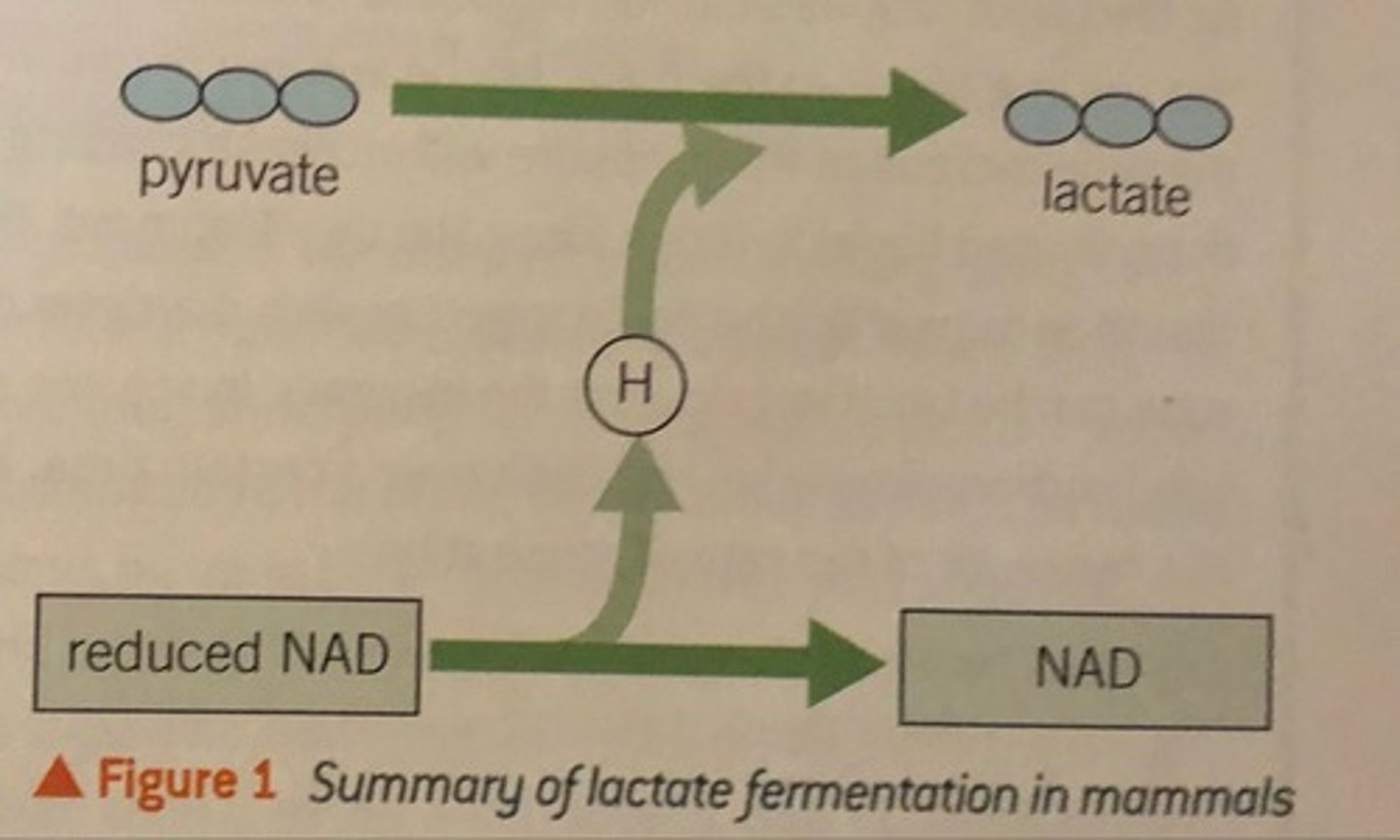
Why do we have an oxygen debt after exercise?
Lactic acid is converted back to glucose in the liver but oxygen is needed to complete this process.
Why can lactate fermentation not occur indefinitely?
The reduced amount of ATP is not enough to maintain vital processes for a long period of time.
The accumulation of lactic acid causes a fall in pH leading to proteins denaturing. Respiratory enzymes and muscle filaments are made from proteins and will cease to function at low pH.
Why is increasing the blood supply and flow through muscles a good aim when improving physical fitness?
To increase the rate of lactic acid removal allowing the intensity and duration of exercise to increase.
Summarise alcoholic fermentation in yeast (and many plants).
Name the enzymes involved in this process.
Pyruvate is converted to ethanal, catalysed by pyruvate decarboxylase.
Ethanal can then accept a hydrogen from NADH, becoming ethanol.
The regenerated NAD can then continue to act as a coenzyme and glycolysis can continue.
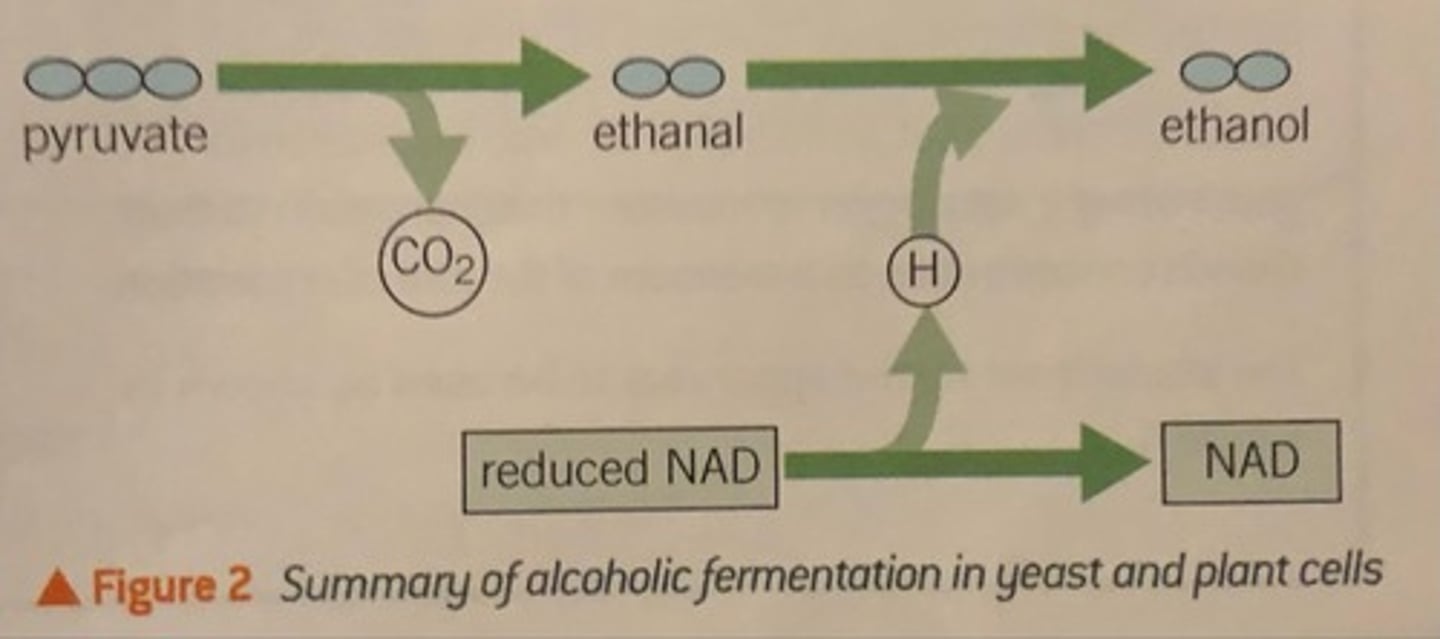
Is alcoholic fermentation a reversible process, like lactate fermentation?
No.
This is also not short term and can continue indefinitely in the absence of oxygen.
Ethanol is a toxic waste product and is toxic in high amounts to yeast cells.
True or false: Glucose is the only respiratory substrate that is broken down to release energy for the synthesis of ATP.
False.
There are many other respiratory substrates, like triglycerides.
How are triglycerides used as respiratory substrates?
They are hydrolysed to fatty acids, which enter the Krebs cycle via acetyl CoA and glycerol.
Glycerol is converted to pyruvate and undergoes oxidative decarboxylation, producing an acetyl group picked up by coenzyme A, forming acetyl CoA.
The fatty acids in a triglyceride can lead to the formation of as many as 50 acetyl CoA, and 500 ATP molecules.
Lipids store and release about twice as much energy as carbohydrates. (proteins are roughly equivalent to carbs).
How are proteins used to produce ATP?
Proteins are hydrolysed to amino acids and then they have to be deaminated before they enter the respiratory pathway, usually via pyruvate.
These steps require ATP, reducing the net production of ATP.
What is the respiratory quotient (RQ)?
Ratio of CO2 produced to O2 consumed.

Why do lipids have a lower RQ than carbohydrates?
Lipids contain a high proportion of carbon-hydrogen bonds which is why they produce so much more ATP in respiration.
Due to the greater number of C-H bonds, lipids require more oxygen to break them down and release less CO2.

What is the RQ value during anaerobic respiration?
The RQ value increases above 1.0.
Describe a procedure to investigate the rate of respiration with a small invertebrate with that of a mung bean.
Comment on the results you might expect from this experiment and the conclusions you may draw.
Mass of invertebrate and mass of beans the same.
Safe and ethical use of invertebrates.
Bigger syringe needed.
Keep the temperature constant/same for both assays.
Keep light constant.
Use same mass of soda lime in both.
Measure the distance moved by the coloured red fluid at regular time intervals.
Repeat experiments.
Results and conclusions:
-Invertebrates rate of respiration is expected to be higher.
-Invertebrates are moving.
-Metabolic processes require energy/generate heat.